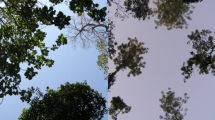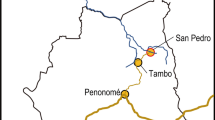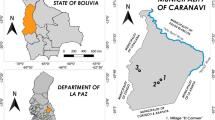Abstract
Shade coffee agroforestry systems have the potential to support biodiversity. Sustainable certification of coffee has been promoted as a means to provide incentives to maintain these systems, but as yet there is little evidence if this is effective. We analyzed tree diversity on smallholder organic and conventional farms in buffer zones of three conservation areas in Costa Rica, Guatemala and Nicaragua (the later included some large-scale conventional and Rainforest Alliance certified farms). Organic farms had greater farm level tree species richness and Shannon diversity compared to conventional farms; estimated native tree species richness across the landscape was probably greater on organic farms than conventional in Nicaragua (48 vs. 28 species respectively) and possibly in Guatemala (23 vs. 15 species respectively). Organic farms had higher shade levels and more tree strata than conventional farms. In Guatemala and Nicaragua tree species composition was not closely related to whether farms were organic or conventional, although within composition clusters, organic farms tended to have greater diversity. In contrast, organic and conventional farms in Costa Rica mostly belonged to different tree species clusters. In Nicaragua most large-scale farms, and all Rainforest certified farms, formed a distinct species composition cluster with presence of old-growth forest species and within which Rainforest farms had greater diversity. Tree species composition of the shade seems to be mainly due to management history; but certification effectively differentiates those farms with greater tree diversity. Longer-term monitoring is required to determine whether certification can be an incentive to conserve or expand biodiverse coffee agroforestry systems within the buffer zones around conservation areas.






Similar content being viewed by others
References
ANACAFE (2008). Green Book: Guatemalan coffees. ANACAFE, Guatemala City. http://www.guatemalancoffees.com/ index.php/greenbook. Accessed 12 Feb 2014
Armbrecht I, Rivera L, Perfecto I (2005) Reduced diversity and complexity in the leaf-litter ant assemblage of Colombian coffee plantations. Conserv Biol 19:897–907
Bakermans MH, Vitz AC, Rodewald AD, Rengifo CG (2009) Migratory songbird use of shade coffee in the Venezuelan Andes with implications for the conservation of the cerulean warbler. Biol Conserv 142:2476–2483
Balia A, Kumarb A, Krishnaswamy J (2007) The mammalian communities in coffee plantations around a protected area in the Western Ghats, India. Biol Conserv 139:93–102
Carlo TA, Collazo JA, Groom MJ (2004) Influences of fruit diversity and abundance on bird use of two shaded coffee plantations. Biotropica 36:602–614
Castro-Tanzi S, Dietsch T, Urenaa N, Vindasa L, Chandler M (2012) Analysis of management and site factors to improve the sustainability of smallholder coffee production in Tarrazú, Costa Rica. Ag Ecosys Environ 155:172–181
CATIE (2002) Sistema geografica sobre area cafetalera de Costa Rica. Informe final al Instituto de Café de Costa Rica, Turrialba
Cerdán C, Lamond G, Pagella T, Soto G, Sinclair FL (2008) Local knowledge of coffee productivity and ecosystem services in coffee plantations surrounding Macizo Peñas Blancas Reserve, Jinotega-Matagalpa Departments, Nicaragua: a guide to using the CAFNET-Nicaragua knowledge base. CATIE, Nicaragua
Colwell RK (2013) EstimateS: statistical estimation of species richness and shared species from samples. Ver 9. Persistent URL http://purl.oclc.org/estimates
Colwell RK, Chao A, Gotelli NJ, Lin S-Y, Mao CX, Chazdon RL, Longino JT (2012) Models and estimators linking individual-based and sample-based rarefaction, extrapolation, and comparison of assemblages. J Plant Ecol 5:3–21
CONAP (2009) IV Informe Nacional de cumplimiento a los acuerdos del convenio de Diversidad Biológica ante la Conferencia de la Partes -CDB. Consejo Nacional de Áreas Protegidas, Guatemala 135p
DaMatta FM (2004) Ecophysiological constraints on the production of shaded and unshaded coffee: a review. Field Crop Res 86:99–114
DeFries R, Hansen A, Newton AC, Hansen MC (2005) Increasing isolation of protected areas in tropical forests over the past twenty years. Ecol Appl 15:19–26
Donald PF (2004) Biodiversity impacts of some agricultural commodity production systems. Conserv Biol 18:17–37
Estrada CG, Damon A, Hernandez CS, Soto Pinto L, Nunez GI (2006) Bat diversity in montane rainforest and shaded coffee under different management practices in southeastern Chiapas, Mexico. Biol Conserv 132:351–361
Galloway G, Beer J (1997) Opportunidades para fomentar la silvicultura en cafetales de America Central. CATIE, Turrialba, Costa Rica. Informe técnico, No 285
Gillison AN, Liswanti N, Budidarsono S, van Noordwijk M, Tomich TP (2004) Impact of cropping methods on biodiversity in coffee agroecosystems in Sumatra, Indonesia. Ecol Soc 9:7–13
Gobbi J (2000) Is biodiversity-friendly coffee financially viable? An analysis of five different coffee production systems in western El Salvador. Ecol Econ 33:267–281
Gotelli NJ, Colwell RK (2011) Estimating species richness. In: Magurran AE, McGill BJ (eds) Frontiers in measuring biodiversity. Oxford University Press, New York, pp 39–54
Greenberg R, Bichier P, Cruz Angon A, Reitsma R (1997) Bird populations in shade and sun coffee plantations in Central Guatemala. Conserv Biol 11:448–459
Haggar J, Jerez R, Cuadra L, Alvarado U, Soto G (2012) Environmental and economic costs and benefits from sustainable certification of coffee in Nicaragua. Food Chain 2:24–41
Haggar J, Medina B, Aguilar RM, Munoz C (2013) Land use change on coffee farms in southern Guatemala and its environmental consequences. Environ Manag 51:811–823
Hardner J, Rice R (2002) Rethinking green consumerism. Sci Am 286:88–95
Harvey CA, Villalobos JAG (2007) Agroforestry systems conserve species-rich but modified assemblages of tropical birds and bats. Biodivers Conserv 16:2257–2292
Harvey CA, Komar O, Chazdon R, Ferguson BG, Finegan B, Griffith DM, Martinez-Ramos M, Morales H, Nigh R, Soto-Pinto L, Van Breugel M, Wishnie M (2008) Integrating agricultural landscapes with biodiversity conservation in the Mesoamerican hotspot. Conserv Biol 22:8–15
Leal IB, Filgueiras J, Gomes L, Iannuzzi A (2012) Andersen. Effects of habitat fragmentation on ant richness and functional composition in Brazilian Atlantic forest. Biodivers Conserv. doi:10.1007/s10531-012-0271-9
Lemmon P (1956) A spherical densitometer for estimating overstory density. Forest Sci 2:314–320
Lopez-Gomez AM, Williams-Linera G, Manson RH (2008) Tree species diversity and vegetation structure in shade coffee farms in Veracruz, Mexico. Agr Ecosyst Environ 124:160–172
MAGFOR (2002) Elaboración del mapa de cultivo de café en Nicaragua. Ministerio de Agricultura Ganadería y Forestal, Managua
Magurran AE (2004) Measuring biological diversity. Blackwell Publishing, Oxford
Mas AH, Dietsch TV (2004) Linking shade coffee certification to biodiversity conservation: butterflies and birds in Chiapas, Mexico. Ecol Appl 14:642–654
Mendez VE, Gliessman SR, Gilbert GS (2007) Tree biodiversity in farmer cooperatives of a shade coffee landscape in western El Salvador. Agr Ecosyst Environ 119:145–159
Millennium Ecosystem Assessment (2005) Ecosystems and human well-being: synthesis. Island Press, Washington, DC
Moguel P, Toledo VM (1999) Biodiversity conservation in traditional coffee systems in Mexico. Conserv Biol 13:11–21
Muschler RG (2001) Shade improves coffee quality in a suboptimal coffee zone of Costa Rica. Agrofor Syst 85:131–139
Myers N, Mittermeier RA, Mittermeier CG, Da Fonseca GAB, Kent J (2000) Biodiversity hotspots for conservation priorities. Nature 403:853–858
Noble IR, Dirzo R (1997) Forests as human-dominated ecosystems. Science 277:522–525
Payton ME, Greenstone MH, Schenker N (2004) Overlapping confidence intervals or standard error intervals: what do they mean in terms of statistical significance? J Insect Sci 3:34
Perfecto I, Snelling R (1995) Biodiversity and the transformation of a tropical agroecosystem: ants in coffee plantations. Ecol Appl 5:1084–1097
Perfecto I, Vandermeer J (2002) The quality of the agroecological matrix in a tropical montane landscape: ants in coffee plantations in southern Mexico. Conserv Biol 16:174–182
Perfecto I, Vandermeer JH, Bautista GL, Nunez GI, Greenberg R, Bichier P, Langridge S (2004) Greater predation in shaded coffee farms: the role of resident neotropical birds. Ecology 85:2677–2681
Philpott SM, Bichier P, Rice R, Greenberg R (2007) Field-testing ecological and economic benefits of coffee certification programs. Conserv Biol 21:975–985
Polzot C (2004) Carbon storage in coffee agroecosystems of Southern Costa Rica: potential applications for the Clean Development Mechanism. MSc. Thesis, Faculty of Environmental Studies, York University, Toronto, Ontario
Potts F, van der Meer J, Daitchman J (2010) The State of Sustainability Initiatives Review 2010: Sustainability and Transparency. IISD, IIED, Aid Environment, UNCTAD and ENTWINED
R Development Core Team R (2012) A language and environment for statistical computing. R Foundation for Statistical Computing, Vienna, Austria. www.R-project.org/
Rice RA (2008) Agricultural intensification within agroforestry: the case of coffee and wood products. Agr Ecosyst Environ 128:212–218
Rice RA, Ward JR (1996) Coffee, conservation and commerce in the western hemisphere. Smithsonian Migratory Bird Center, Washington, DC
SAN (2010) Sustainable Agriculture Standard. Sustainable Agriculture Network, San Jose, Costa Rica. http://www.rainforest-alliance.org/agriculture/documents/sust_ag_standard_july2010.pdf
Santos-Barrera G, Urbina-Cardona JN (2011) The role of the matrix-edge dynamics of amphibian conservation in tropical montane fragmented landscapes. Revista Mexicana de Biodiversidad 82:679–687
Schulze CH, Waltert M, Kesler PJA, Pitopang R, Shahabuddin, Veddeler, Muehlenberg MD, Gradstein SR, Leuschner C, Steffan-Dewenter I, Tscharntke T (2004) Biodiversity indicator taxa of tropical land-use systems: comparing plants, birds and insects. Ecol Appl 14:1321–1333
Siebert SF (2002) From shade- to sun-grown perennial crops in Sulawesi, Indonesia: implications for biodiversity conservation and soil fertility. Biodivers Conserv 11:1889–1902
Solis-Montero L, Flores-Palacios A, Cruz-Angon A (2005) Shade-coffee plantations as refuges for tropical wild orchids in central Veracruz, Mexico. Conserv Biol 19:908–916
Soto-Pinto L, Perfecto I, Castillo-Hernandéz J, Caballero-Nieto J (2000) Shade effects on coffee production at the Northern Tzeltal zone of the State of Chiapas, Mexico. Agric Ecosyst Environ 80:61–69
Soto-Pinto L, Romero-Alvarado Y, Caballero-Nieto J, Warnholtz GS (2001) Woody plant diversity and structure of shade-grown-coffee plantations in Northern Chiapas, Mexico. Rev Biol Trop 49:977–987
Soto-Pinto L, Perfecto I, Caballero-Nieto J (2002) Shade over coffee: its effects on berry borer, leaf rust and spontaneous herbs in Chiapas, Mexico. Agroforest Syst 55:37–45
Staver C, Guharay F, Monterroso D, Muschler RG (2001) Designing pest-suppressive multistrata perennial crop systems: shade-grown coffee in Central America. Agrofor Syst 53:151–170
Tscharntke T, Clough Y, Bhagwat SA, Buchori D, Faust H, Hertel D, Holscher D, Juhrbandt J, Kessler M, Perfecto I, Scherber C, Schroth G, Veldkamp E, Wanger TC (2011) Multifunctional shade-tree management in tropical agroforestry landscapes—a review. J Appl Ecol 48(3):619–629
Vandermeer J, Perfecto I (2007) The agricultural matrix and a future paradigm for conservation. Conserv Biol 21:274–277
Acknowledgments
This research was supported by the EC funded Project “CAFNET: Connecting, enhancing and sustaining environmental services and market values of coffee agroforestry in Central America, East Africa and India” EC Contract number EuropeAid/ENV/2006/114-382/TPS which had no involvement with the design or analysis of the research, and the DEFRA/Darwin Initiative funded Project 19-018 “Agroforests: a critical resource for sustaining megadiversity in Guatemala”. Elias de Melo and Gabriela Soto of the Tropical Agricultural Research and Higher Education Centre (CATIE) in Costa Rica coordinated the CAFNET Project in Central America and supervised parts of this research. Cesar Tot of Fundacion Defensores de la Naturaleza, and Luis Cuadra and Urbina Alvarado students at the National Agrarian University supported the implementation of the research in Guatemala and Nicaragua, respectively. We thank Stephen Young for his advice on the statistical analysis.
Author information
Authors and Affiliations
Corresponding author
Additional information
Communicated by Peter J. T. White.
Rights and permissions
About this article
Cite this article
Haggar, J., Asigbaase, M., Bonilla, G. et al. Tree diversity on sustainably certified and conventional coffee farms in Central America. Biodivers Conserv 24, 1175–1194 (2015). https://doi.org/10.1007/s10531-014-0851-y
Received:
Revised:
Accepted:
Published:
Issue Date:
DOI: https://doi.org/10.1007/s10531-014-0851-y




